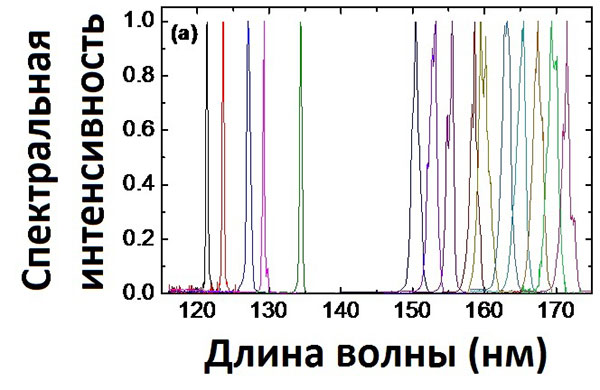Generation of fs pulses down to 121 nm in strontium tetraborate
The researchers of the Laboratories of Coherent Optics and Crystal Physics in cooperation with scientists from the Max Born Institute for Nonlinear Optics and Ultrafast Spectroscopy (Berlin, Germany) carried out a series of investigations on the nonlinear optical properties of as-grown domain structures in the crystals of orthorhombic strontium tetraborate (α-SBO), which is a promising nonlinear VUV optical material. It lacks both angular phase matching and ferroelectricity; therefore, phase matching in α-SBO can now be implemented only via random quasi-phase-matching or nonlinear diffraction with the use of random domain structures (nonlinear photonic crystals, NPCs) discovered at the Kirensky Institute of Physics.
The α-SBO NPCs formed in separate growth experiments have the structure favorable to a certain nonlinear-optical process in different spectral ranges. For VUV generation, a 928-µm-thick NPC sample was used. This sample yields the best results for radiation generation in the 200-nm range. A fundamental radiation source was either the third harmonic of a fs Ti: sapphire laser system (266 nm, 1-kHz repetition rate, 70-fs pulse duration) or the second harmonic of fs OPA (242-344 nm, 0.2−3 µJ). The fundamental beam was focused to a diameter of 300 µm within the NPC. The VUV radiation was analyzed with a McPherson 234/302 monochromator equipped with an Andor D0420-BN-995 CCD array optimized for VUV detection. Normalized generated VUV radiation spectra are presented in Fig. 1.

Fig. 1. Spectra of VUV radiation generated in the α-SBO NPC.
Continuous tuning of the VUV central wavelength is obtained in the range 170−121 nm. Discreteness of tuning in Fig. 1 is due to the fundamental source tuning conditions, while the NPC does not impose any tunability restrictions. Radiation at 121 nm obtained in this experiment is the shortest-wavelength coherent radiation that has ever been obtained in the solid state. The conversion efficiency measured at 160 nm is 5 10-5, which is typical of strongly randomized α-SBO NPCs available at the current state of technology. The energy of generated VUV pulses depends quadratically on the fundamental one; however, at the highest fundamental energies it turns to the linear one, revealing the presence of a limiting factor, related, most likely, to two-photon absorption of generated quanta at the interband transition in the presence of fundamental photon flux. The VUV radiation obtained in the α-SBO NPC was used in absorption measurements at 160 nm. The absorbance of the crystal grown at the Kirensky Institute of Physics was smaller than that of the crystal grown in China by more than order of magnitude.
- P. Trabs, F. Noack, A. Aleksandrovsky, A. Vyunishev, A. Zaitsev, N. Radionov, and V. Petrov, Generation of fs-pulses down to 121 nm by frequency doubling using random quasi-phase-matching in strontium tetraborate, in Proc. 9th Int. Conf. UFO-2013, Davos, March 4-8, 2013, p. 34.
- A. S. Aleksandrovsky, Nonlinear optical processes and DUV generation in random domain structures of SBO, in CLEO: 2015, OSA Technical Digest (online) (Opt. Soc. Am., 2015), paper STh3H.1
- P. Trabs, F. Noack, A. S. Aleksandrovsky, A. Zaitsev, and V. Petrov, Generation of coherent Vacuum UV radiation in randomly quasi-phase-matched strontium tetraborate, in CLEO: 2015, OSA Technical Digest (online) (Optical Society of America, 2015), paper STh3H.2.
